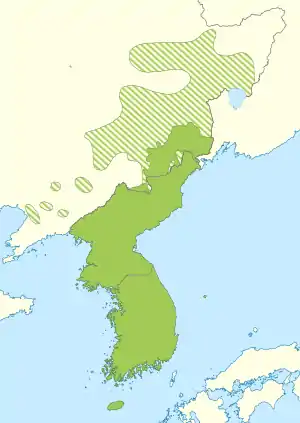Koryo-mar
Koryo-mal, Goryeomal, or Koryŏmal (Korean: 고려말, Russian: Корё мар) is the dialect of Korean spoken by the Koryo-saram, ethnic Koreans in the countries of the former Soviet Union. It is descended from the Hamgyŏng dialect and multiple other varieties of Northeastern Korean.[1] Koryo-saram often report difficulty understanding speakers of standard Korean; this may be compounded by the fact that the majority of Koryo-saram today use Russian and not Korean as their first language.[2]
| Koryo-mal | |
|---|---|
| 고려말 / Корё мар | |
| Pronunciation | [ko.ɾjo.maɾ] |
| Native to | Uzbekistan, Russia, Kazakhstan, Kyrgyzstan |
| Ethnicity | Korean |
Native speakers | (220,000 cited 1989) current number of speakers is unknown |
| Hangul | |
| Language codes | |
| ISO 639-3 | – |
| Glottolog | None |
| Korean name | |||||||
|---|---|---|---|---|---|---|---|
| Chosŏn'gŭl | 고려말 | ||||||
| Hancha | 高麗말 | ||||||
| |||||||
| Russian name | |||||||
| Russian | Корё мар | ||||||
| Romanization | Koryo mar | ||||||
According to German Kim, Koryo-mar is not widely used in the media and is not taught in schools. Thus it can be classified as endangered.[3]
Names
In the speech of Koryo-saram, the language is referred to as Koryo-mar (고려말/корё мар), with several alternative pronunciations, including Kore-mar (коре мар) and Kore-mari (коре мари).
In South Korea, the dialect is referred to as Goryeomal (고려말) or Central Asian Korean (중앙아시아한국어).
In Russia and other former Soviet states, the language is referred to as Koryo-mar (корё мар) or Koryo-mal (корё маль), of which the former reflects the spoken form while the latter reflects the literary form of Korean.
Orthography
Speakers do not generally use Koryo-mar as a literary language. Written Korean during the Soviet period tended to follow the North Korean standard language, while both Northern and Southern forms have occurred after the dissolution of the Soviet Union. However, some modern writers, most notably Lavrenti Son, have created plays and short stories in Koryo-mar using Hangul.[4]
A movement for the romanization of Koryo-mar took place in the late 1930s, promoted by various government officials and linguists, but it did not have much success.[5]
Phonology
Characteristics of Koryo-mar distinct from that of Standard Korean include the following phonological differences:[6]
- ㄹ is [ɾ] or [r] in all positions except when geminate, where it is pronounced the same as standard Korean
- frequent loss of ㄹ before coronal consonants
- A pitch accent system that distinguishes minimal pairs; it has two tones, high and low
- the retention of MK initial n before [i] and [j]
- ㄱ is [t͡ɕ] before ㅣ
- ㄴ and ㅇ at the end of a word are simplified to 이
- ㅏ, ㅔ are pronounced as ㅑ; and ㅗ is pronounced as ㅔ
- ㅗ, ㅡ are simplified to ㅜ; and ㅣ is interchangeable with ㅡ
- [w] is pronounced as [v] due to Russian influence
- ㅈ is pronounced as ㄷ
- ㄱ is pronounced as ㅂ in the middle of a word
Pedagogy
Koryo-mar is not taught as a subject or used as the medium of instruction in any schools. The Korean language as taught in universities of the post-Soviet states is Standard Korean, with instructors being native to or trained. In one instance, a South Korean professor tried to teach Koryo-mar at Almaty State University, but he did not achieve much success.[7]
References
- Kwak, Chung-gu (2007). "Data and Ressarches for Korean dialect in Central Asia" (PDF). Journal of Humanities (in Korean). 85: 231–272 – via Institute of Humanities.
- Khan, Valeriy Sergeevich. "Koreans and the Poly-ethnic Environment in Central Asia: The Experience of Eurasianism". Seoul: Academy of Korean Studies. Archived from the original on September 27, 2007. Retrieved 2006-11-20.
- Kim, German. "Education and Diasporic Language: The Case of Koreans in Kazakhstan" (PDF). The Slavic-Eurasian Research Center.
- Kim, Phil. "Forced Deportation and Literary Imagination". Seoul: Academy of Korean Studies. Archived from the original on 2005-07-29. Retrieved 2006-11-20.
- Kim, German. "The History, Culture, and Language of Koryo Saram" (PDF). Seoul: Kyujanggak Institute for Korean Studies. Retrieved 2012-08-08.
- Tranter, Nicolas (2012). The Languages of Japan and Korea. Routledge. ISBN 978-1-136-44658-0.
- Kim, German. "Korean Diaspora in Kazakhstan: Question of Topical Problems for Minorities in Post-Soviet Space" (PDF). Almaty: Institute of Oriental Studies, National Academy of Sciences.
Further reading
- Reckel, Johannes; Schatz, Merle, eds. (2020), Korean Diaspora – Central Asia, Siberia and Beyond, Universitätsverlag Göttingen, doi:10.17875/gup2020-1307, ISBN 978-3-86395-451-2.

